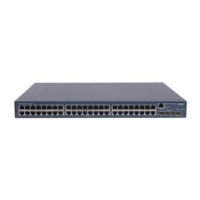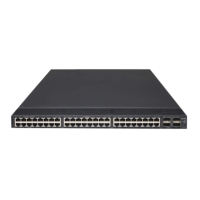1-4
As shown in Figure 1-1, Device B and Device C lie on Ring 1 and Ring 2. Device B’s Port 1 and Port 2
and Device C’s Port 1 and Port 2 access the primary ring, so they are common ports. Device B’s Port 3
and Device C’s Port 3 access only the subring, so they are edge ports.
RRPP ring group
To reduce Edge-Hello traffic, you can configure a group of subrings on the edge node or assistant-edge
node. For information about Edge-Hello packets, refer to
RRPP Packets. You must configure a device
as the edge node of these subrings, and another device as the assistant-edge node of these subrings.
Additionally, the subrings of the edge node and assistant-edge node must connect to the same subring
packet tunnels in major ring (SRPTs), so that Edge-Hello packets of the edge node of these subrings
travel to the assistant-edge node of these subrings over the same link.
A ring group configured on the edge node is called an edge node ring group, and a ring group
configured on an assistant-edge node is called an assistant-edge node ring group. Up to one subring in
an edge node ring group is allowed to send Edge-Hello packets.
RRPP Packets
Table 1-1 shows the types of RRPP packets and their functions.
Table 1-1 RRPP packet types and their functions
Type Description
Hello
The master node initiates Hello packets to detect the integrity of a ring in
a network.
Link-Down
The transit node, the edge node or the assistant-edge node initiates
Link-Down packets to notify the master node of the disappearance of a
ring in case of a link failure.
Common-Flush-FDB
The master node initiates Common-Flush-FDB packets to instruct the
transit nodes to update their own MAC entries and ARP/ND entries when
an RRPP ring transits to Disconnect state.
Complete-Flush-FDB
The master node initiates Complete-Flush-FDB packets to instruct the
transit nodes to update their own MAC entries and ARP/ND entries, and
release blocked ports from being blocked temporarily when an RRPP ring
transits to Health state.
Edge-Hello
The edge node initiates Edge-Hello packets to examine the links of the
primary ring between the edge node and the assistant-edge node.
Major-Fault
The assistant-edge node initiates Major-Fault packets to notify the edge
node of a failure when a link of primary ring between edge node and
assistant-edge node is torn down.
Hello and Fail Timers
When RRPP checks the link state of an Ethernet ring, the master node sends Hello packets out the
primary port according to the Hello timer and determines whether its secondary port receives the Hello
packets based on the Fail timer.
z The Hello timer specifies the interval at which the master node sends Hello packets out the primary
port.
z The Fail timer specifies the maximum delay between the master node sending Hello packets out
the primary port and the secondary port receiving the Hello packets from the primary port. If the

